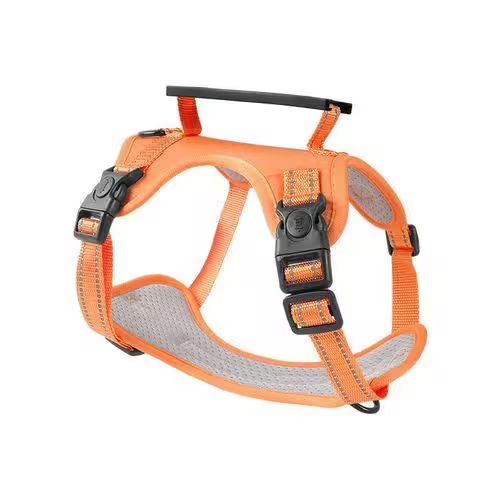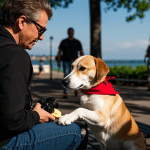Anyone who has owned a senior dog knows that that once-energetic furry child may now be panting after two steps, or even resting on the ground and refusing to move. A 13-year-old dog is the equivalent of a human in their 70s,How old is a 13 year old dog in human years?
Their joints, cardiorespiratory fitness and energy reserves are all in decline, but stopping exercise altogether can accelerate the deterioration of their health instead.

Just how long should I walk my dog? What is the safest way to walk your dog? This article will give you a scientific answer, combining veterinary advice and real-life examples.
Read more:
Is a 13 year old dog old? The ‘longevity code’ you must know
Is 10 old for a small dog?Dog Age Calculator
Changes in fitness in older dogs: look at these 3 indicators first
1. Breed and size
- Small dogs (e.g. Chihuahua): may still be active at 13 years old, but have a high heart burden and need to control the duration.
- Medium-sized dogs (e.g. Labrador): arthritis-prone group, over-exercise may trigger pain.
- Large dogs (e.g. German Shepherd): high risk of hip dysplasia, short multiple walks are desirable.
2. Health status
- Arthritis: over 60% of older dogs suffer from the disease, manifested by slow rise and refusal to jump.
- Heart disease: coughing, easy to wheeze need to reduce the intensity of exercise.
- Cognitive Impairment: Dogs that are lost or dazed are not suitable for long walks.
3. Daily Habits
- If the dog is used to 1 hour daily walks since childhood, it can be reduced to 20-30 minutes in old age.
- Long-term indoor dogs can be stressed by a sudden increase in outdoor time.
13 Year Old Dog Walking Hour Calculator for Dogs
Don’t use the same standards you used when you were younger! Daily exercise for older dogs = weight in pounds x 0.5 minutes + joint health factor. An example:
- 70 lb Labrador: 70 x 0.5 = 35 minutes + arthritis minus 10 minutes = 25 minutes
- 15 lb Poodle: 15 x 0.5 = 7.5 minutes + health plus 5 minutes = 12.5 minutes
Veterinary advice: dog walking hours for different conditions
1. Healthy senior dogs: 15-30 minutes/day
- Segmented: walk for 10-15 minutes in the morning and 10-15 minutes in the evening to avoid one-time fatigue.
- Speed control: at a speed that the dog can follow easily (usually 0.8-1.2 meters/second).
2. Dogs with arthritis: 5-15 minutes/day
- Choose soft ground: Grass and land are better for joints than concrete.
- With warmth: Wear knee pads or jacket in fall and winter to prevent stiffness from increasing.
3. Dogs with heart problems: 10 minutes or less/day
- Avoid slopes: walk on level ground and keep heart rate under 90 beats per minute (touch chest count for 15 seconds x 4).
- Pause at any time: if panting does not resume for more than 1 minute, go home immediately.
Choosing the right time to walk your dog in different seasons
Older dogs’ biological clocks are more accurate than weather forecasts:
Prime dog walking times in winter
- Northern states: 1-3 p.m. (surface temperatures 5-8 degrees Fahrenheit higher than morning)
- Southern states: 10 a.m. (avoid frost damage to paw pads)
- Rainy and snowy days: in segments of no more than 8 minutes at a time
Summer Heatstroke Prevention Program
- Pre-walk preparation: soak your pet’s cool-sense clothing in cool water, which can cool it down for 2 hours
- Ground test: the back of the hand against the ground for 5 seconds is not hot before release
- Rehydration Rhythm: Feed 1 ounce of electrolyte water (1:3 dilution of sports drink) every 10 minutes
4 danger signs: stop walking your dog immediately!
- Limping or leg dragging: possible ligament tear or nerve compression.
- Purple tongue: sign of oxygen deprivation, commonly associated with heart failure.
- Vigorous panting + salivation: precursor to heat stroke (can happen even if temperatures are not high).
- Incontinence: physical exhaustion or spinal problems.
Real Case: a 13-year-old golden retriever suffered a hip dislocation and a $5,000 dollar surgery due to his owner’s insistence on walking him for 45 minutes a day.
Other Dangerous Self-Checks:
Return home immediately if any of the following occur:
White paw pads: precursor to poor circulation (massage with a warm towel)
Tail droop: usually occurs 15 minutes before panting
Licking joints more than 3 times/minute: a silent cry for help from pain
Bowel movement during walks: warning of insufficient blood supply to the intestines
Dog walking upgrade tips: making exercise safer and more effective
1. Switch to a chest harness.
- Collars can compress the trachea of older dogs. Choose a Y-shaped chest harness to distribute the pressure.
- Recommended brand: Ruffwear Front Range (with handles to support your dog at all times).

2.Increase sniffing games
- Hide snacks on walk routes and let your dog sniff them as you go – 10 minutes of sniffing is equivalent to 30 minutes of walking exertion.
- Use a leaky toy: let your dog chew on it for 10 minutes before leaving the house to reduce excitement.
3. Temperature Management
- Summer: choose early morning before 7am or evening after 7pm when the ground temperature is <30℃.
- Winter: wear waterproof boots to prevent frostbite, change to indoor activities in sub-zero weather.
Exclusive Dog Walking Route Design for Older Dogs
Turn walks into rehab training:
1、Alternating soft and hard surfaces (optimal combination):
Lawn 30% → relieve joint pressure
Plastic walkway 40% → stimulate paw nerves
Sand 30% → for balance
2、Sniffing adventure game:
Hide 3 freeze-dried pellets in a bush to stimulate cognitive abilities
Changing weekly routes reduces risk of dementia by 27
3,Social Distance Control:
Stay 10 feet or more from other dogs (reduces stress)
Snacks to direct attention when encountering excited pups
Alternative: when walks are no longer feasible
If your dog is seriously resistant to going outside, try these low-intensity exercises:
1. Water walks
- A hydrotherapy pool at a pet rehab center can reduce joint stress for 10 minutes twice a week.
- Put 5cm of warm water in a home bathtub and guide your dog back and forth (non-slip mat required).
2. Indoor Obstacle Course
- Use pillows and cardboard boxes to set up a simple pathway and guide your dog through it for 5 minutes a day.
- Use commands (e.g. “turn around”, “wait”) to keep your dog’s mind active.
3. Massage and Stretch
- Spend 5 minutes a day massaging the muscles of the back legs (push from the feet to the buttocks).
- Gently stretch the front leg: hold the elbow slowly forward and hold for 3 seconds.
List of mandatory equipment
- Pet Pedometer:
- FitBark or Whistle device tracks steps, 2000-4000 steps per day recommended for senior dogs.
- Setting overload reminder: APP automatically alarms when exceeding the set number of steps.
2.Heart rate monitoring chest strap:
- Voyce core sensor shows heart rate in real time and pauses exercise when it exceeds 120 beats per minute.
These artifacts can make the old dog walk safer:
| Gear | Features | Hot Selling Models in the USA |
|---|---|---|
| Double Loop Leash | Distribute Neck Stress | Ruffwear Front Range |
| Silicone Paw Socks | Anti-slip and anti-frost crack | QUMY Dog Boots |
| Gen7Pets Wander | Gen7Pets Wander | Gen7Pets Wander |
| Smart Collar | Real-time heart rate and fatigue value monitoring | Fi Series 3 |
Note: Stroller use time ≤ 1/3 of the total dog walking time, to avoid muscle atrophy!
Summary: Quality is more important than duration
For a 13-year-old dog, a 15-minute pleasure walk every day is far better than an hour of forced walking. Remember the three principles:
- Observation takes precedence: rest when your dog stops to sniff, don’t rush.
- Flexibility to adjust: switch to indoor scavenger hunts on rainy days and shorten the distance on hot days.
- Regular Evaluation: Have your vet check joints and cardiorespiratory function every 3 months.
After all, the best gift we can give our senior dogs isn’t sticking to an “exercise program,” but rather making their old age comfortable and reassuring every step of the way.



